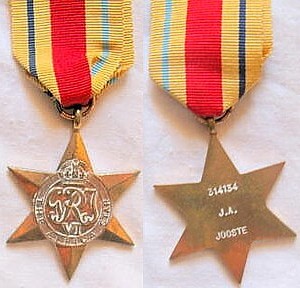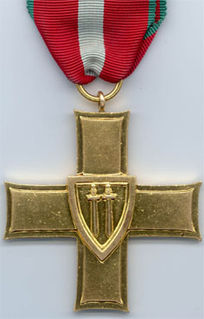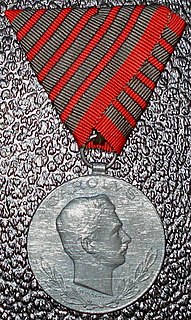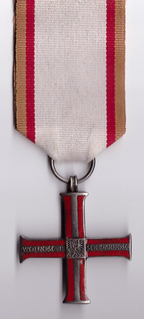
A service star is a miniature bronze or silver five-pointed star 3⁄16 inch in diameter that is authorized to be worn by members of the seven uniformed services of the United States on medals and ribbons to denote an additional award or service period. The service star may also be referred to as a campaign star or battle star depending on which award is authorized the star and the manner in which the device is used for the award.

The American Defense Service Medal was a military award of the United States Armed Forces, established by Executive Order 8808, by President Franklin D. Roosevelt, on June 28, 1941. The medal was intended to recognize those military service members who had served on active duty between September 8, 1939 and December 7, 1941.

The Africa Star is a military campaign medal, instituted by the United Kingdom on 8 July 1943 for award to British and Commonwealth forces who served in North Africa between 10 June 1940 and 12 May 1943 during the Second World War.
The NATO Medal is an international military decoration which is awarded to various militaries of the world under the authority of the North Atlantic Treaty Organization (NATO). It is manufactured by Eekelers-Centini Intl, of Hemiksem, Belgium. There are currently fourteen versions of the NATO Medal in existence, for service in the former Yugoslavia, Kosovo, Macedonia, two for service during Article 5 operations, and eight for Non-Article 5 NATO operations. In addition, there are corresponding clasps for operations such as ISAF, Kosovo, the former Yugoslavia, NTM-I, and clasps designating Article 5, and Non-Article 5 designations. There is also a NATO Meritorious Service Medal, with a "Meritorious Service" clasp as well. However, U.S. military personnel do not wear the clasps on the NATO Medals, since the U.S. has its own devices that are used instead.
The United States Armed Forces authorizes certain medal and ribbon devices that may be worn if authorized on a defined set of United States military decorations and awards. The devices vary between 3⁄16 inch to 13⁄32 inch in size and are usually attached to suspension and service ribbons of medals and to unit award ribbons. The devices are usually made of brass or metal alloys that appear gold, silver, or bronze in color with either a dull or polished look. The devices may denote additional awards of the same decoration or award, an award for valor or meritorious combat service, participation in a particular campaign, periods of honorable service, specific events, and other special meanings. These are sometimes referred to as award devices, but are most commonly referred to in service regulations and Department of Defense instructions simply as "devices" for awards and decorations.

Dziennik Ustaw or Dziennik Ustaw Rzeczypospolitej Polskiej is the most important Polish publication of legal acts. It is the only official source of law for promulgation of Polish laws. The publication of this journal is solely the responsibility of the Prime Minister of the Republic of Poland. 'Dziennik Ustaw' traces its history to the 1918 'Dziennik Praw Królestwa Polskiego' and has changed its name several times during its existence.

The 1939–1945 Star is a military campaign medal, instituted by the United Kingdom on 8 July 1943 for award to British and Commonwealth forces for service in the Second World War. Two clasps were instituted to be worn on the medal ribbon, Battle of Britain and Bomber Command.

The Burma Star is a military campaign medal, instituted by the United Kingdom in May 1945 for award to British and Commonwealth forces who served in the Burma Campaign from 1941 to 1945, during the Second World War.

The France and Germany Star is a military campaign medal, instituted by the United Kingdom in May 1945 for award to British Commonwealth forces who served in France, Belgium, Luxembourg, the Netherlands or Germany and adjacent sea areas between 6 June 1944 and 8 May 1945, during the Second World War.

The Order of the Cross of Grunwald was a military decoration created in Poland in November 1943 by the High Command of Gwardia Ludowa, a World War II Polish resistance movement organised by the Polish Workers Party. On 20 February 1944 it was confirmed by the State National Council and on 22 December by the Polish Committee of National Liberation and further confirmed on 17 February 1960 by the government of the People's Republic of Poland.

The Wound Medal was a decoration of the Empire of Austria-Hungary. It was established on August 12, 1917 by Emperor Karl and was the last medal to be officially founded in the empire.
Colombian military decorations date back as far as the founding of the country. An early decoration was the Cruz de Boyacá that was awarded to the generals who led their forces to victory in the Battle of Boyacá in 1819. This early decoration lives on today as an incarnation of the highest order presented by the Colombian state. There is one decoration higher, but it is only awarded for military conflicts in defence of Colombia. Other than military decorations, Colombia presents decorations on behalf of the National Government, decorations for the National Police, and decorations from the Congress of Colombia.

The Medal of the 10th Anniversary of People's Poland is a former Polish civil state award established by the Council of State on 23 May 1954 to recognize services to the state.

The Medal for Merit to Culture – Gloria Artis or Gloria Artis Medal, is a departmental decoration of Poland in Arts awarded by the Ministry of Culture and National Heritage of the Republic of Poland to persons and organizations for distinguished contributions to, or protection of the Polish culture and national heritage.

The Order of the Cross of Independence was established on 5 August 2010, to honor those who between the years of 1939-1956 voluntarily served with merit in defending the independence of the Polish State. At its establishment it was declared to be a continuation of Cross of Independence which was established on 29 October 1930. It is fifth in the order of precedence of Polish awards and decorations.

The Common Security and Defence Policy Service Medal, is an international military decoration awarded to individuals, both military and civilian, who have served with CSDP missions. Since the 1990s the European Union has taken a greater role in military missions both in Europe and abroad. These actions were taken under the Common Security and Defence Policy (CSDP), which is implemented by the European Union Military Staff, a department of the EU. To recognize service in these missions the EU authorized the creation of a medal with a common obverse and reverse, to which clasps featuring the missions' name are attached to the ribbon bar.

The Cross of Freedom and Solidarity was established on 5 August 2010, to honor members of the democratic opposition in Poland who between the years 1956 and 1989 were killed, seriously wounded or injured, arrested, imprisoned or interned for at least 30 days, who lost jobs or were expelled from school or university for at least 6 months as a result of their activities for the benefit of a free and democratic Poland. Individuals who are found having collaborated with the communist regime may not be awarded.

The Arctic Star is a military campaign medal instituted by the United Kingdom on 19 December 2012 for award to British Commonwealth forces who served on the Arctic Convoys north of the Arctic Circle, during the Second World War.

The Commemorative Cross of the 1916–1918 War is a Romanian First World War campaign medal established on 8 July 1918 by Royal Decree. The Decree was amended four times, in 1919, 1920, 1927 and 1939.






















